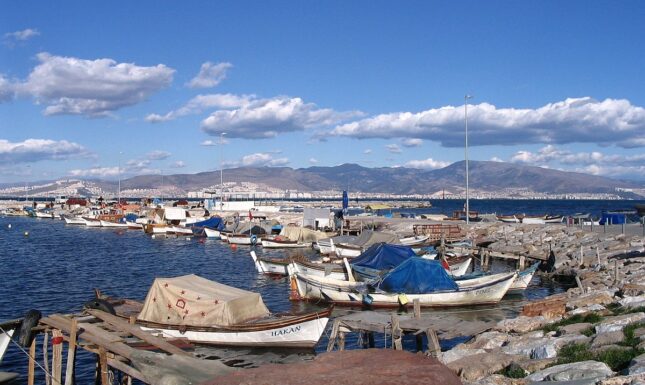Ships and Shipwrecks: What an Ancient Latin Poem Can Tell Us about Meloni’s Immigration Policies
A Latin poem by one of Catullus’ fellow poets and the immigration policies adopted by Italy’s far-right-led government share a similar perspective on non-European people. In this blog post, Francesco Busti reflects on Europe’s millennia-old exploitative attitudes towards the rest of the world.
26 February 2023. A boat of non-European migrants seeking asylum in the EU collides with reefs off Calabria’s coastline and kills dozens of people. Some of the boat’s remains end up on the beach near Steccato di Cutro (municipality of Cutro). Among them is a life preserver with the word Smyrna, the ancient name of Izmir, the Turkish port from which the boat departed.


9 March 2023. Italy’s Prime Minister Giorgia Meloni holds a Cabinet meeting in Cutro instead of Rome to stress her far-right-led government’s resolve to crack down on people smugglers. The “Cutro decree” establishes a new offence: death or injuries resulting from crimes involving illegal immigration. Opposition politicians criticise Meloni’s punitive approach and call for humanitarian corridors to assist asylum-seekers.
When I first read about the shipwreck and its resonance in Italian politics, I immediately thought of another vessel, a literary one. This vessel appeared sometime before the mid-first century BCE in a poem by the Roman poet Catullus (no. 95) comparing two literary works: the Zmyrna, by one of Catullus’ friends, Cinna; and the Annales, by a certain Volusius, clearly not amongst Catullus’ friends. The two works were worlds apart. Cinna’s Zmyrna narrated a Cypriot girl’s incestuous love for her father. Volusius’ Annales celebrated Rome’s military achievements.
Catullus envisages contrasting fates for these poems: Cinna’s Zmyrna will be a bestseller, while Volusius’ Annales will flop. He illustrates these antithetical outcomes through a nautical metaphor: the small light boat Zmyrna will travel as far away as Cyprus, while the heavy warship Annales will sink right after its launch.
I have been studying Cinna’s Zmyrna (survived only in fragments) since I moved to Leiden to work as a postdoc in Latin literature at LUCAS in October 2022. The Cutro shipwreck suddenly provided a dramatic backdrop for what seemed merely poetic imagery. The comparison between a boat of migrants departed from Izmir and a metaphorical vessel embodying a Latin poem entitled Zmyrna may seem to go no further than a name. Yet this is hardly the case.
Surprisingly enough, Cinna belonged to that very military world with which Catullus contrasts him. He took part in Rome’s eastward expansion. He went to Bithynia (Asia Minor), fought for Rome’s annexation of the region and enslaved Parthenius, a Bithynian poet (cf. Suda s.v. Parthenios: Parthenius “was taken by Cinna as booty”). Also, he “carried” to Rome a copy of a poem by Aratus, another poet from Asia Minor, “aboard a Bithynian boat,” as he tells us himself (fr. 13.4 Hollis). However, the most valuable item of Cinna’s Bithynian booty must have been the Zmyrna. He began working on it probably right after returning from Bithynia, and there is evidence of Parthenius’ influence on its topic.
Catullus’ “review” of Cinna’s Zmyrna confirms its status as the direct product of Rome’s military invasion of Asia. By proclaiming its superiority over Volusius’ Annales, Catullus declares the latter’s failure to incarnate Rome’s martial prowess and appoints Cinna as the actual conqueror of Asia. Viewed as a ship “penetrating deep” (95.5) as far as Cyprus, Cinna’s Zmyrna enacts Rome’s sexual assault on foreign lands and lays the ground for Rome’s subsequent exploitation of their human and material resources.


Meloni’s conceptualization of immigration is framed similarly. In 2019, as a Member of Parliament, Meloni accused France of using a “colonial currency” to “exploit the resources” of African countries. “The solution is not to take Africans and move them to Europe; the solution is to free Africa from certain Europeans who exploit it […].” Although in a different tone, Meloni voiced similar concerns following the Cutro decree, which she intended as a measure to “combat the slavery of the Third Millennium.”
However, Meloni’s position on immigration is not as straightforward as it sounds. She often claimed that the ultimate purpose of pro-immigration policies is “ethnic substitution,” a conspiracy theory asserting that white people risk genocide owing to a deliberate plot to replace them with non-white immigrants. Ethnicity plays a significant role in Meloni’s views on immigration, which she does not oppose per se. In 2018, she declared that “every nation has the right to favour an immigration more compatible with its culture.” “Do we need immigrants? Let’s take them from Venezuela,” where most people are Christian and of Italian origin.
This last statement is highly revealing. Despite her claim to bring about a radical change in Italy’s immigration policies, Meloni phrased her proposal (“Let’s take them from Venezuela”) with the same vocabulary she used to describe the policies she opposed (“The solution is not to take Africans and move them to Europe”). In Meloni’s view, immigrants, be they Venezuelans or Africans, are resources to be taken from their native countries and moved to Europe, and one would do better to choose those who best match one’s interests. This perspective is not different from that of Cinna, announcing that he “carried” to Rome a copy of a poem by Aratus in a ship that probably accommodated not only loot from Bithynia but also enslaved people like Parthenius, “taken as booty.”
In Catullus’ poem on Cinna’s Zmyrna, an imaginary ship starting its literary journey from Rome to Asia mirrors Cinna’s real ship sailing in the opposite direction with material and human plunder from Asia. Meloni wants to prevent a change in this model, which has served Europe’s interests for millennia. In this model, the initiative in transferring material and human resources from foreign to European soil must come from Europe itself, and foreign goods and people are passive objects of plunder. From this perspective, a ship of migrants actively seeking asylum in Italy from Asia Minor symbolizes an ethnic invasion of Italy, and stopping this “invasion” amounts to preventing Italy from being treated the way Rome treated Asia Minor in Cinna’s day. The issue is one of agency: in this system, whether from Rome or Izmir, the ship must sail with a European at the helm.

© Francesco Busti and Leiden Arts in Society Blog, 2024. Unauthorised use and/or duplication of this material without express and written permission from this site’s author and/or owner is strictly prohibited. Excerpts and links may be used, provided that full and clear credit is given to Francesco Busti and Leiden Arts in Society Blog with appropriate and specific direction to the original content.



0 Comments